What is Dog Crate?
We’ve all heard the phrase, ‘Every dog has its day,’ right? I’d like to add to that and say each dog should have their crate. A dog crate isn’t merely a cage made of metal or plastic; it’s a private space where my pet can relax and feel safe. It serves as a refuge during times of stress and a cozy spot for sleep.
I’ve come to realize that crates, when used appropriately, can be a great resource for training and providing a secure environment for dogs. Knowing the appropriate times and ways to use a crate is vital to ensure a good experience for my dog. Selecting the right size and style is also important, as comfort is paramount.
By understanding my dog’s requirements and introducing the crate slowly, it has become a well-accepted part of our routine.
Key Takeaways
To sum it up, a dog crate does more than provide a safe spot—it acts as a sanctuary for our pet dogs. A happy dog makes a happy home, and it rings true here. In this guide, we’ve walked through the advantages of using a dog crate, the best time to introduce one, and some advice on usage.
We’ve discussed how to choose the right crate, steps for effective training, and strategies to deal with possible challenges. All this is to make sure that your pet dog feels safe and loved. If done with care and consideration, crate training can become a gratifying journey, leading to peaceful nights and joyfully wagging tails.
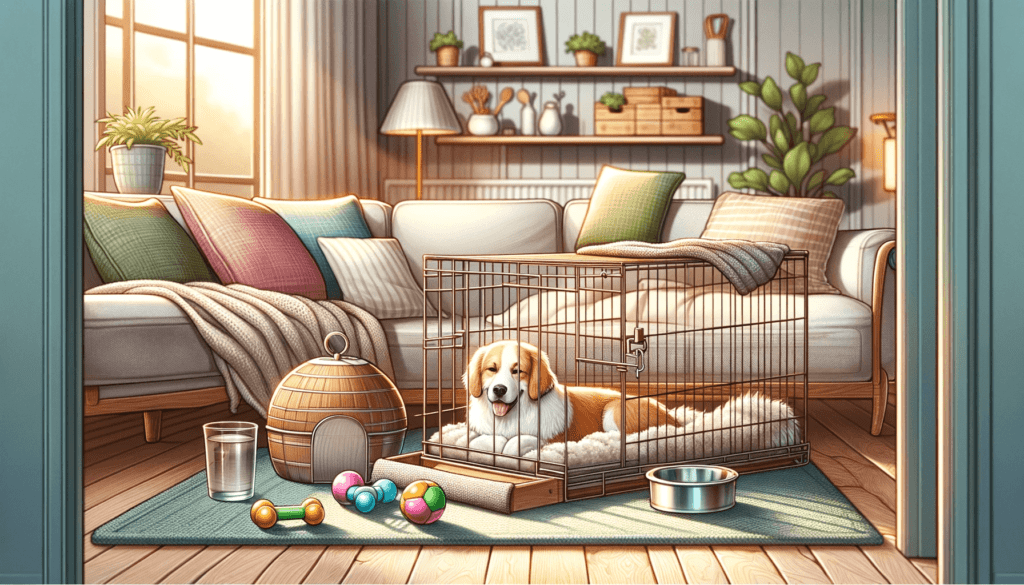
What Are the Benefits of Using Dog Crates?
Dog crates provide a secure, practical way to move our pets while maintaining their safety. My experience as a pet owner has shown me the value of crate training in raising a content, well-mannered dog. It’s not just about providing a spot for my dog when I’m not home; it’s about creating a personal space where my pet feels secure and at ease.
Safety is a top priority when it comes to dog crates, so I always make sure the crate is appropriately sized for my pet, allowing them to stand, spin around, and lie down comfortably. It’s also important to ensure the crate is robust and doesn’t contain any sharp edges or potential dangers that could injure my pet.
For dogs dealing with separation anxiety, a dog crate can become a refuge. With the right training, they understand that the crate is a haven where they can unwind, significantly decreasing stress when they’re home alone. In addition, crates are vital for house training, as dogs instinctively avoid messing up their sleeping area, assisting them in learning to hold it until they’re outside.
Finally, in terms of behavior training, a dog crate can be priceless. It offers a controlled setting to correct bad behaviors and set up better ones, making it a key tool in my pet training kit.
“Dogs are not our whole life, but they make our lives whole. The crate has become a vital part of this whole, providing safety, comfort, and a training tool.”


When Is the Right Time to Consider Purchasing a Dog Crate?
The question of when to invest in a dog crate is a common one among pet owners. The answer is straightforward: as soon as you bring a new dog or puppy home. Dog crates serve multiple purposes, from providing a safe space for your pet to rest to aiding in training.
Here are some instances when a dog crate can be particularly beneficial:
- Training a puppy: Dog crates play a vital role in housebreaking a new puppy. It sets up a routine and offers a secure spot for your new pet to relax.
- Providing a sleeping space: A crate fitted with a comfy bed can serve as a secure and snug sleeping area for your pet, ensuring they get a good night’s rest.
- Used in behavioral training: A crate is not just for housebreaking, but it can also be used in behavioral training and for setting boundaries in your home.
When choosing a dog crate, size is a major factor to consider. It should be spacious enough for your dog to stand, turn around, and lie down without discomfort. Paying attention to these details is crucial, as a too-small or too-large crate will not fulfill its purpose efficiently.
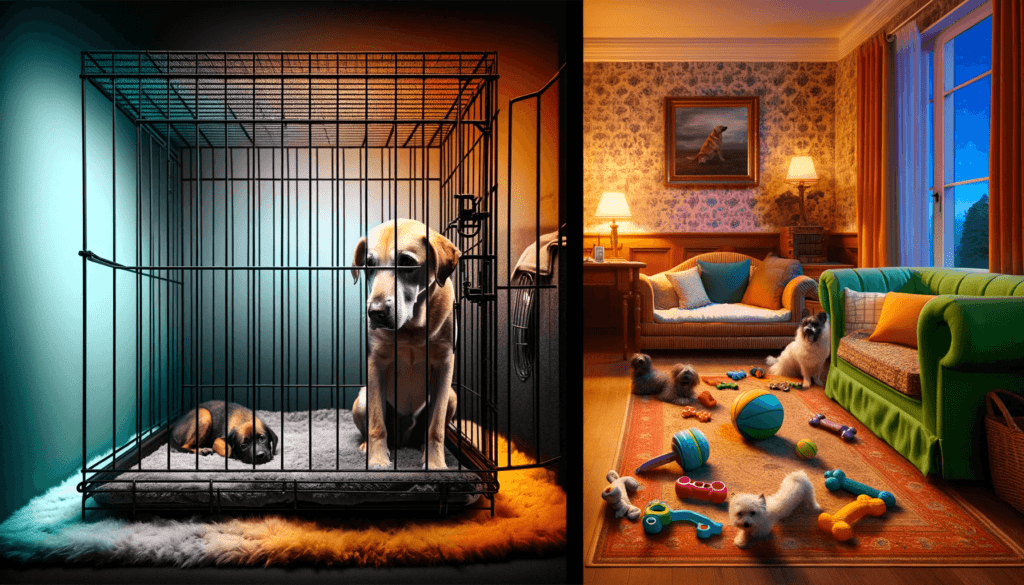

When Should a Crate Not Be Used?
Dog crates can be a beneficial tool for pet owners. However, there are certain circumstances when it’s not the best option, such as when the crate is causing discomfort or undue stress. For instance, if your dog shows signs of fear or anxiety when in the crate, it’s time to reconsider its use.
Ideally, a crate should serve as a refuge for your anxious dog, not a trigger for stress. In such situations, it’s worth considering alternatives to dog crates that can offer a cozy, stress-free space.
When it comes to training your pet to use the crate, patience, and positive reinforcement hold the key. It’s a good practice to bear in mind that a crate isn’t a form of discipline. If your dog seems reluctant to use the crate, pushing it may do more damage than good. Instead, try associating the crate with positive experiences, like adding a preferred blanket or a beloved toy.
To wrap up, the purpose of a crate is to ensure safety, not to replace the necessary training or physical activity for your dog. It isn’t a place for your pet to stay all day. If you need to be away for long hours, perhaps it would be better to think about hiring a dog sitter or opting for a doggy daycare service. Always remember that the welfare of your pet should always be your biggest concern.
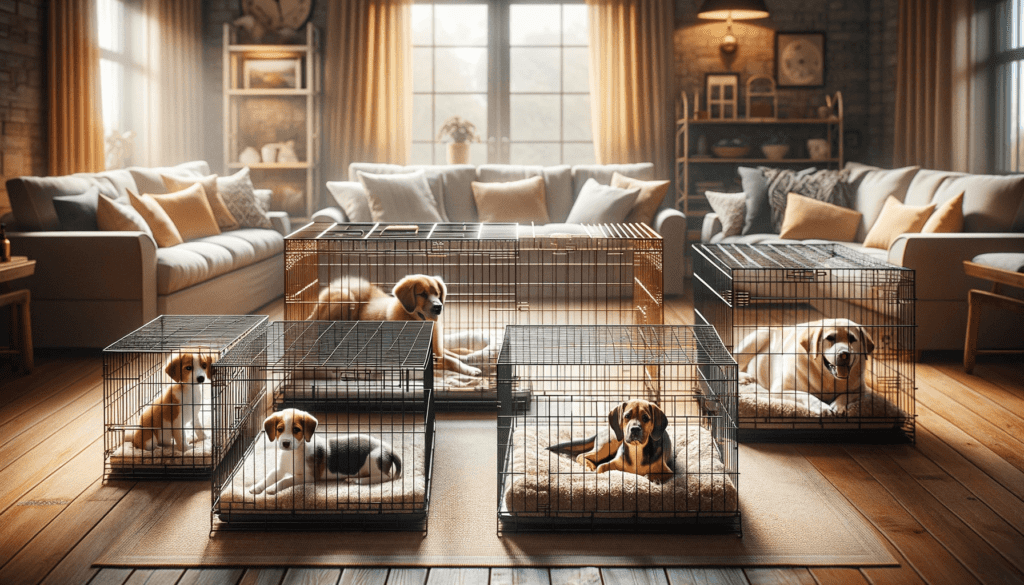

Identifying Dog Breeds Suitable for Crate Training
Crate training is an excellent tool that can be beneficial for most dogs, especially young pups and adolescents who are still in the process of understanding household rules and parameters. A crate for a puppy can serve as a comfortable and secure retreat for them. It isn’t merely about restriction – it’s a critical component in setting a routine, assisting in-house training, and curbing destructive behaviors when the puppy isn’t under direct supervision.
To break it down, here are some noteworthy points:
- Puppy Crate: It’s a great way to foster a positive environment that promotes good behavior in a puppy.
- Dog Crate Training: It’s a powerful tool that can help dogs of any age deal with anxiety and become accustomed to spending structured time alone.
- Crate Training Benefits: It provides a safe way to transport your dog, guarantees their safety during emergencies, and offers a space for crate games that boost mental stimulation.
Training your dog to be comfortable in a crate is a process that requires patience and a positive attitude. Whether you’re using a dog crate for playing games that stimulate your dog’s mind or as a strategy for house training, it’s crucial to keep in mind that the end goal is to have a content and well-adjusted dog. When done right, crate training is a gesture of care and guidance.


Choosing the Ideal Crate
Choosing the perfect crate for your pet is more than just a matter of size. It’s about ensuring your pet’s comfort and safety and creating a space they can call their own. Let me guide you through the process of determining your dog’s size and needs. A crate is not just a container; it’s a safe place that can adapt as your dog grows and changes.
Tips for Choosing the Correct Crate Size for Your Dog
Determining the appropriate crate size for your dog depends on their physical dimensions and the intended use of the crate. The goal is to provide a comfortable space for your dog where they can move with ease, but not so much room that it could interfere with house training. Here are some steps I take when figuring out the perfect crate size for a dog:
- Size Up Your Dog: Get the length from their nose to the base of their tail and their shoulder height, then add a few inches to each dimension.
- Plan for Growth: If you’re crate training a young pup, factor in their projected adult size, or choose a crate with adjustable dividers.
- Define the Purpose: The crate’s use can vary, from a snug hideaway for a small dog to a larger retreat for a big breed, and should be chosen accordingly.
Whether you need a compact crate for a small dog or a more spacious one for a large breed, you’ll find the right fit. This guide aims to help you provide your dog with the perfect safe space; a medium-sized crate may be the best for some, while others may need more room. Above all, your dog’s comfort and safety should be your top priority.
As author and dog expert Cesar Millan wisely said, “A dog is a great teacher of mindfulness. If you can learn to live in the moment like your dog does, you’ll be happier.” That’s why, in choosing a crate, mindfulness of your dog’s needs is key.
Selecting the Appropriate Crate Size
Choosing the Appropriate Dog Crate
Picking out the right crate for my dog involves understanding its function and making sure it fits my dog’s size and comfort levels, without extra room. I often refer to a dog crate size chart to help with this decision.
The crate should be cozy enough to provide a sense of security, but also large enough for my dog to stand, turn around, and lie down with ease.
For those with puppies, a crate that comes with a divider is a smart choice. This feature allows for adjustments as the puppy grows, keeping them from misusing extra space.
The factors that make a dog crate great include durability and how easy it is to clean. For those who own larger dogs, a dog crate designed for large breeds is a must. These crates offer sturdy build quality and plenty of space.
On the other hand, those with smaller dogs should consider a dog crate designed for small breeds, which offers a safe and snug environment for their petite pals.
As one dog owner said, “The right crate makes a world of difference. It’s not just about size, but about finding a crate that makes your dog feel safe and comfortable.” So, when choosing a crate, it’s important to keep your dog’s needs in mind.
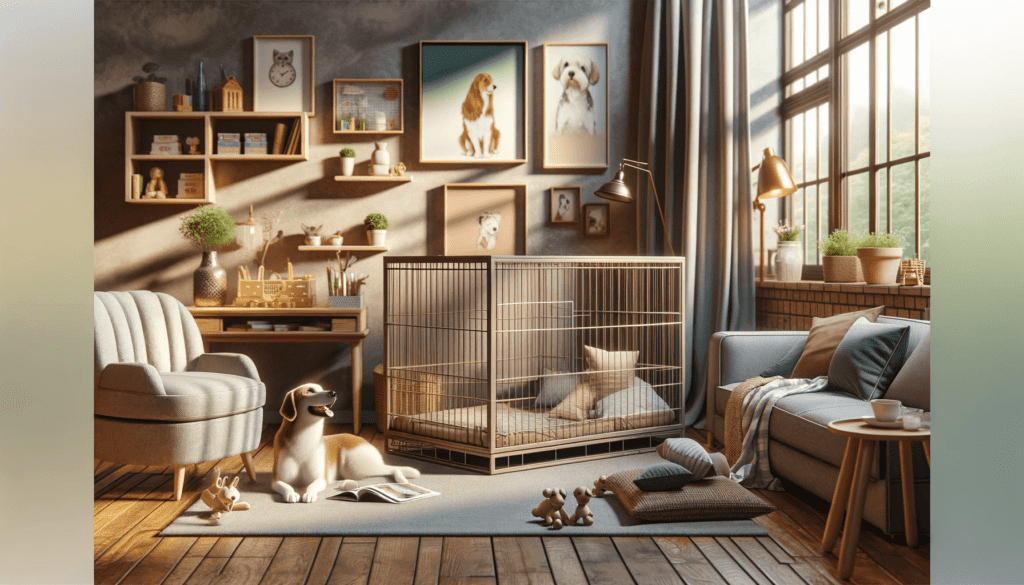

Take into account the Location
Think About the Placement
The location of the dog crate in my home is always a major consideration to make sure it’s practical for my space and comfortable for my dog. The placement can significantly impact my dog’s comfort and the overall look and functionality of my living area. Here are some factors I consider when determining the best spot:
- Ease of Access: It’s important for the crate to be a place my dog can get in and out of with ease.
- Temperature: The spot should be away from harsh sunlight or chilly drafts, especially for crates kept indoors.
- Foot Traffic: Areas with lots of movement can be stressful for dogs, so a quieter spot is preferable.
For outdoor crates, I pay additional attention to weather conditions and safety. If you’re living in an apartment, the crate should be compact yet still provide a secure refuge for your pet. I’ve also come across some tasteful crates that go well with home interiors, making them a worthwhile addition to your living space.
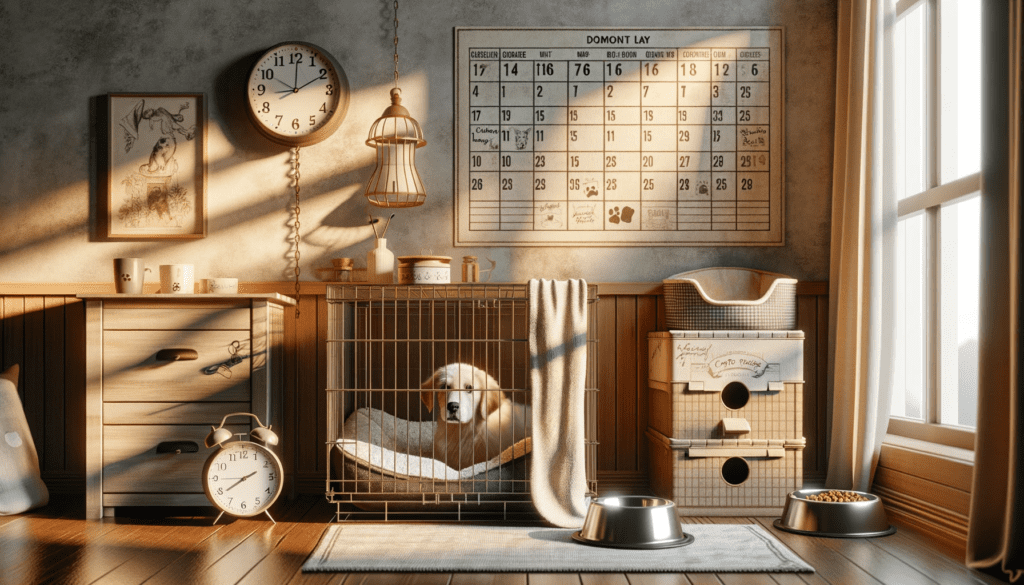

Creating a Consistent Crate Schedule
Creating a Routine for Your Dog’s Crate
Once you’ve identified the ideal spot for your pet’s crate, it’s pivotal to establish a consistent routine. This helps your dog adapt and feel secure. Providing a comfortable environment is paramount, so selecting soft and easily cleanable bedding for the dog crate is a good step.
This makes the crate a warm and inviting space. For night-time use, I have a separate dog crate with additional padding, which aids in a calm and restful night’s sleep.
The crate also functions as a private sanctuary during the day. This is where your dog can take a breather when they need it. I’ve found that dog crate mats are essential. They offer a sturdy yet soft surface that can endure daily use. To give your pet a sense of privacy, dog crate covers can be used. They are very helpful in bustling households or during periods of high activity.
Introduce the crate in a gentle manner, linking it with pleasant experiences like treats and quiet bonding time. Serving meals in the crate can further strengthen this positive connection. By sticking to a regular routine for crate usage, your dog learns what to expect. This can lessen their anxiety and foster trust. The key lies in consistency, comfort, and ensuring the crate feels like a safe haven for your pet.
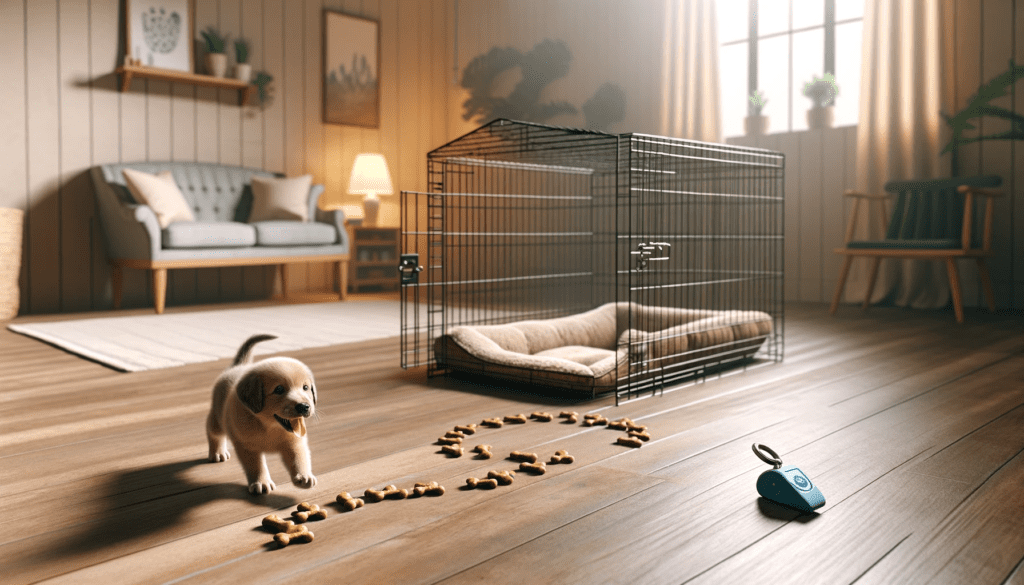

Progressing with Crate Training Techniques
Developing Dog Crate Training Techniques
In the process of training my dog to adapt to a crate, I increase the duration they spend inside it bit by bit. This is to make sure they remain calm and stress-free. As I keep improving my training techniques, I am always keen on observing my dog’s reactions. This slow and measured progression helps to build a positive relationship between the dog and the crate, their personal space.
As I keep refining the training, my main focus remains on my dog’s comfort. I avoid rushing things; instead, I focus on the small wins, like when my dog takes a nap in the crate voluntarily or goes inside it without any prompting. Adopting such a mindful approach ensures a gradual, stress-free shift for the dog to start considering the crate as their safe space.
“Remember, patience is key in dog crate training. Celebrating small victories, like a peaceful nap in the crate, helps in building a stress-free and positive environment for your pet.”
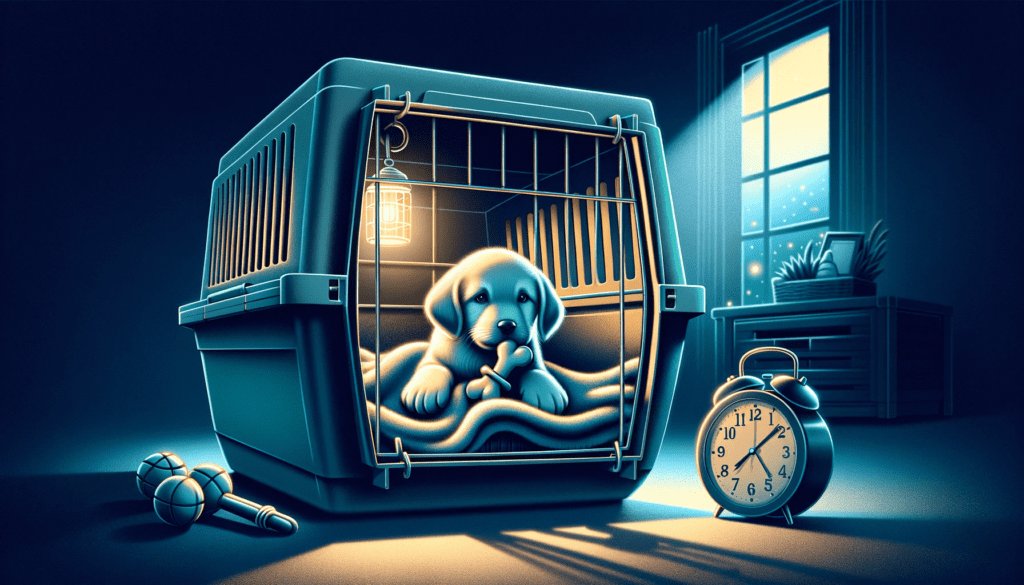

Managing Crate Whining Behavior
Dealing with a Whining Dog in a Crate
From personal experience dealing with my dog’s crate whining, I’ve learned that comprehending their discomfort and addressing it without encouraging the behavior is key. The design of the dog crate should be inviting and secure. If the dog continues to bark, evaluate if they’re conveying a need or just pushing the limits.
To lessen the whining, I’ve chosen a dog crate specifically designed to dampen noise and withstand a pet’s stress. This kind of crate is robust, doesn’t easily shake or make noise in response to the dog’s movements, and can discourage continuous barking.
Another helpful tip I’ve gained is the use of soft dog crate liners. These can provide a comfortable environment inside the crate, which can calm the dog and curb the anxiety that leads to whining. For hygiene, crate liners should be easy to wash and replace, keeping the crate clean and inviting for my pet.
When asked about dog crate suggestions, I always recommend a crate that’s appropriately sized and well-ventilated. It should allow the dog to stand, turn around, and lie down with ease. “Patience is key,” I always say, “Never punish your dog for whining. Instead, help them associate the crate with positive experiences.”
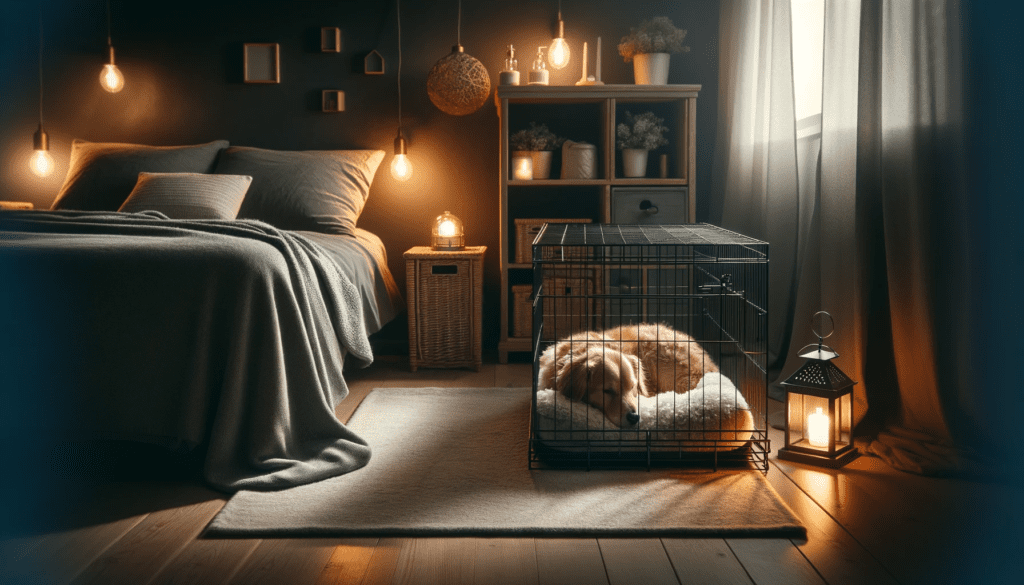

Strategies for Managing Crates at Night
Crate Strategy for Nighttime Dog Care
When it comes to getting a good night’s sleep, both you and your pet deserve nothing less. That’s why having a solid nighttime routine for your dog is so important. An integral part of this routine is having a suitable sleeping setup, specifically, a dog crate. It’s not just about confining your pet; it’s about providing them with a secure and comfortable space to rest.
Here’s how I’ve made my pet’s crate a welcoming and safe haven for sleep:
- A snug, plush bed is placed inside the crate. It offers a soft and cozy surface for my dog to rest on.
- I add a light blanket for that extra bit of warmth. Draping it over the crate gives a den-like feel, reinforcing a sense of security and calm.
- I’ve also attached a durable water bowl that’s resistant to chewing to the crate. This ensures that my dog stays hydrated, even during the night.
I prefer a foldable dog crate due to its practicality. It’s strong enough to secure my adult dog, but it also conveniently collapses for storage or travel. It’s an excellent option for dogs who enjoy their quiet time, offering them a dedicated space to relax after an active day. By prioritizing my dog’s nighttime comfort, we both benefit – a well-rested dog makes for a well-rested owner.
As a pet owner, I believe, “The comfort of our pets is a reflection of our care and love for them.” So, it’s worth investing time and effort into creating a comfortable crate setup for your dog’s nighttime routine. It not only promotes better sleep but also contributes to their overall well-being.
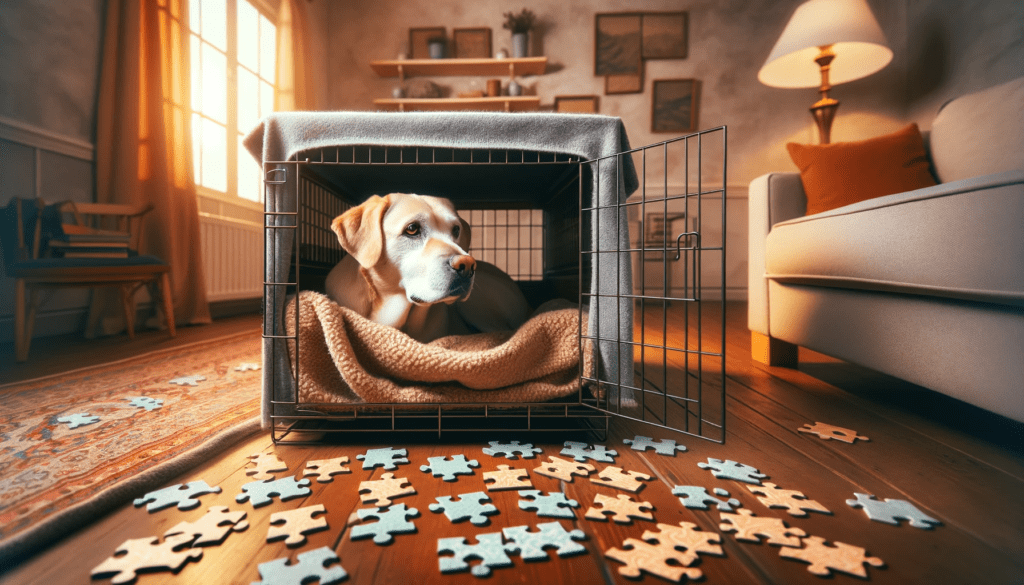

Addressing the Challenges of Crate Use
Despite the solace a snug crate may provide, I’ve encountered hurdles that required solutions to secure my dog’s ongoing comfort and affinity for their crate. The task of crating can be a tad complex, especially when it comes to a crate for a chew-happy dog. My canine pal once considered his crate more of a gnawing object than a sanctuary, leading me to invest in a robust crate constructed to resist those sharp little chompers.
Another important factor was ventilation. Ensuring sufficient air circulation in my dog’s crate was vital to keep my pooch comfortable and safe, especially during the hotter seasons. I opted for a design that provided generous ventilation, guarding my dog against overheating.
Being a pet parent to two dogs, it was necessary for me to search for a crate that could accommodate both. Striking a balance between snugness and room was key so they could live together comfortably without feeling squeezed in.
Keeping the crate clean is a regular chore, so the hunt for dog crates that are a cinch to clean was high on my list. Features like removable trays and non-absorbent materials have made upkeep less of a headache.
Here’s a handy reference table to tackle these challenges:
| Challenge | Solution | Benefit |
|---|---|---|
| Chewing | Robust dog crate | Durability |
| Ventilation | Crate with generous ventilation | Comfort |
| Multiple Dogs | Roomy crate for two | Harmony |
| Cleaning | Simple-to-clean materials | Hygiene |
Frequently Asked Questions
How Can I Make a DIY Dog Crate if I’m on a Tight Budget or Prefer a Customized Solution?
I’m putting together a snug, cost-effective habitat for my canine companion. Using recycled resources such as wooden pallets and soft bedding, I plan to construct a personalized crate that is not only cost-effective but also made with a great deal of affection.
Is It Possible to Crate Train an Older Dog That Has Never Been Introduced to a Crate, and What Are the Specific Challenges?
Indeed, it’s feasible to teach an older dog how to get used to a crate—a task that might prove to be a bit difficult compared to training younger canines. The key is to approach this with a lot of patience and a consistent reinforcement of positive behavior. Older dogs may not be as open to new experiences as their younger counterparts, hence the need for a more thoughtful approach.
A quote from Benjamin Franklin comes to mind: “An ounce of patience is worth a pound of brains.” This is particularly true when it comes to crate training older dogs. It might be a bit of a challenge, but with the right amount of patience and understanding, it’s certainly possible.
Can Crating a Dog Lead to Separation Anxiety or Exacerbate Existing Anxiety Issues?
Absolutely, the practice of crating a dog can potentially result in separation anxiety or can exacerbate existing anxiety issues if the crate duration and the dog’s comfort level around the crate aren’t carefully considered. Keeping a close eye on a pet’s behavior becomes a priority in such situations.
How Should I Approach Crate Training if My Dog Has a Negative Association With a Crate From Past Experiences?
The approach to crate training for a dog with unfavorable past experiences should be done slowly and gently. The process involves using positive reinforcement techniques to foster good feelings towards the crate. The key to success is patience; the ultimate goal is to guarantee that the dog identifies the crate as a safe and comfortable space.
Are There Any Breed-Specific Modifications or Considerations to Keep in Mind When Crate Training, Particularly Large or Small Dogs?
In the context of crate training, there can be a lot of worry about whether the size of the dog will affect the process. Rest assured, though, that crate training can be adapted for any dog size. For larger breeds, I make sure there’s plenty of room in the crate, while for the smaller ones, I ensure a snug and comfortable environment to prevent them from feeling overwhelmed.
Conclusion
So, to wrap things up, a dog crate serves as more than just a safe space—it’s a haven for our pet dogs. As the saying goes, ‘a blissful dog paves the way for a cheerful household.’ I’ve guided you through the benefits, the ideal timing to introduce one, and the do’s and don’ts.
We’ve touched upon how to select the perfect crate, steps for successful training, and ways to overcome potential struggles, all to ensure your furry companion feels secure and treasured. When accomplished with kindness, crate training can transform into a rewarding experience, paving the way for restful evenings and wagging tails.
